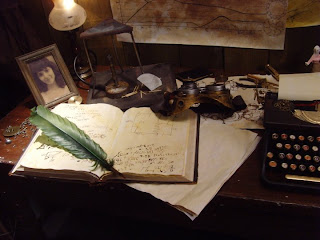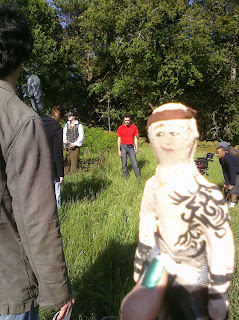 So the shoot is complete. 120 slates in three days. Vague memories of awesome shots and electrifying performances set against a stunning backdrop. How much of that is really true, and how much is the result of my state of general confusion is hard to say. I have viewed barely any of the footage back - the exception being low-res imagery for the backplates when we were filming the greenscreen.
So the shoot is complete. 120 slates in three days. Vague memories of awesome shots and electrifying performances set against a stunning backdrop. How much of that is really true, and how much is the result of my state of general confusion is hard to say. I have viewed barely any of the footage back - the exception being low-res imagery for the backplates when we were filming the greenscreen.Let's try and take it in order.
So we got the set up on Tuesday, and from the moment I saw it, I was blown away. We had some minor issues with a wall that was about a meter shorter than we had anticipated, but an upended table blended in remarkably well and we were soon fussing around with the smaller things. At every point, I was trying to step back, re
strain the control-freak inside me, and let Luisa get on with her job. And she got on brilliantly. I want to say publicly that without Luisa, Broken Bubbles would have been a tenth of the film it has turned out to be. No matter how convincing the performances, if they were acted against a poor set, or a generic modern room, the film would have flopped disastrously. Thanks to Luisa's consistent dedication, we had a lifelike set, a spectacular array of props and beautiful set of costumes.
On Tuesday evening, we got the kit into the space, set the light
s, fired up the camera... and saw nothing. Apparently, fitted with a zoom lens, the RED is incapable of fully opening the aperture, resulting in a very poor sensitivity to low light. So we abandoned our Peppers and Dedos and started flooding the place with a 2K and 650s. Although it looked washed out to the eye, we achieved a pleasantly moody look on the RED with which
we were all generally happy.
Wednesday morning started with an attempt to set the general lighting set, and although I had hoped to have it done the night before, it wasn't long before it was ready and we were filming Slate 1, Take 1. From there, it was a marathon till Slate 120, Take X roughly 60 hours later. I was very grateful to David van der Zanden for the energetic, focussed and resolute way he kept us all to it. There were plenty moments of more light-hearted banter, but nowhere along the line did the production slip off the rails. Meanwhile, lunch was scheduled for the middle of the day, and although this slipped on Friday, we managed to get a proper break and the crew were happier as a result and worked harder.
There were many times I thought we wouldn't make it, and looking back, I am considerably surprised we did. The film should really have been filmed over four days. I appreciate that in the real world we might not be able to raise the budget for a four day RED shoot, but for the purposes of the film we had in fr
ont of us, with all the necessary complexities of greenscreen, of a fantasy setting, of an 11 page script and a crew working with equipment for the first or second time, a three-day-shoot seems unhelpful and cramping.
One of the first decisions we made in the pre-production process was to film by set-up rather than by scene. This I discovered to be remarkably confusing - far more so than it sounded on paper. It resulted in multiple minor panic attacks where I wondered if we had got a particular shot. Reassured by John, David and occasionally by Rhys, I am confident we have hardly missed anything, but at the time it caused me some consternation. However, this convoluted shooting order was vital in accomplishing the film over the time allotted.
We also decided to film the destruction sequence handheld, and everything else on the tripod. I wanted the chaotic movements to mirror Grabulous' mental breakdown. The subsequent post-apocalyptic scene was filmed in different lighting, with different camera positions. We wanted to illustrate the fact that Grabulous wakes as a new man. Everything is different. Whether this works in the edit, or whether it jars awkwardly remains to be seen.

Thursday afternoon was the scenes in Mugdock Park. This was a source of particular worry to me, especially as the weather was against us at the beginning. But we were particularly blessed as the rain melted away just as we were setting up for the first scene. By the evening, the sun had broken o
ut and the camera guys were almost jumping up and down on the spot looking at the glorious sunset on the monitor. There were issues: the midgies being number one, and the battery charging system being number two, but we did alright. It highlights the need for drivers on a shoot. It's not great when the make-up artist has to double up as Runner!
Friday afternoon was the green screen. Initially scheduled for all afternoon and evening, we squashed everything into 90 minutes. We run the risk that we have a poor special effect, but John, David and myself were all 100% agreed that it was more important to finish the workshop scenes and get a good story and a good performance, than to compromise for the sake of a special effect. At the worst, if the special effect is disastrous, we can adapt it with a re-shoot or an animated fairy. It's of much less consequence than the workshop scenes with the performances that go with it.
I was delighted with the way the whole team pulled together in the making of this. The camera team were tireless, Graeme ploughed thr
ough on a totally new piece of audio equipment, the art department never failed, Phil doubled his workload by being Producer and DIT after Gavin Rizza suddenly discovered he had been scheduled as DIT for the shoot and we suddenly discovered he was unavailable. In particular, the way the Heads of Department worked together was brilliant.

I especially enjoyed working with John as DoP. From the first meeting we had in pre-production where he showed me some of the pictures he had found as references, I knew we were on the same page. By the time of Thursday shooting, I was deliberately only watching the monitor during the technical rehearsal or first take. After that, I left John to watch the monitor and I tried to watch the actors in the flesh. It's easier to see the nuances of performance that way. I trusted John to know if the shot was good or needed a tweak. Our levels of communication developed to the point of me saying "You know, it's that one... with the thing" and John nodding confidently: "Oh yeah, yeah!" and heading off to set up the shot.
All in all, I've enjoyed every minute of it. It's made me more keen than ever to learn the craft of directing and it's a pleasure to work alongside such talented actors, artists and film-makers as those with which I am surrounded.
 Here we have an example of the modern and ancient blend. The microphone is a Shure 55 model, popular in 1950’s America
Here we have an example of the modern and ancient blend. The microphone is a Shure 55 model, popular in 1950’s America Saturninus’ faction has a clear parallel with fascism. The Mercedes in which Saturninus rides is identical to the transport favoured by Hitler when he was joining in marches. The parallels between the first picture above and the picture below are remarkable.
Saturninus’ faction has a clear parallel with fascism. The Mercedes in which Saturninus rides is identical to the transport favoured by Hitler when he was joining in marches. The parallels between the first picture above and the picture below are remarkable. 

 On the hood of the car, and on the front of each of the motorbikes, we have an ornamental wolf head. This motif of the wolf occurs again and again throughout the film, and is a reference to the twin founders of Rome, Romulus and Remus. Legend has it they were raised by wolves.
On the hood of the car, and on the front of each of the motorbikes, we have an ornamental wolf head. This motif of the wolf occurs again and again throughout the film, and is a reference to the twin founders of Rome, Romulus and Remus. Legend has it they were raised by wolves.

